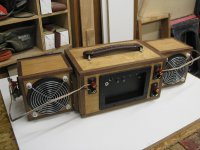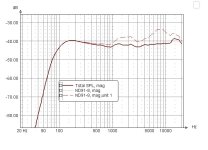Yes, that near field response appears to show box resonances. If there was no damping material in the box it would be interesting to stuff the box with damping material, fiberglass batting, rockwool, tightly packed dacron or maybe acoustic foam and repeat that near field measurement to see what resonances get reduced. Bracing the box walls or applying some butyl rubber backed foil damping material may also help with panel resonances. It can be informative to measure the box output with no drive signal in Power Spectral Density display mode while rapping on the side of the box walls to see what the resonant frequencies are of the panels. The Arta software has a real time spectrum mode that computes the FFT and displays it.
Here's an example of a panel resonance I measured by knocking on a wood panel.

Here's an example of a panel resonance I measured by knocking on a wood panel.
Last edited:
Me too. Like Arta, REW has a PSD function. It's the Button third from the right labeled RTA, Real Time Analyzer.
Here I pushed the record button, top left corner of graph with red dot, then whistling into the mic. Click [Reset averaging] just
before you knock on a panel and then hit stop to measure panel resonances.

Here I pushed the record button, top left corner of graph with red dot, then whistling into the mic. Click [Reset averaging] just
before you knock on a panel and then hit stop to measure panel resonances.
If you aren't able to resurrect or re-use the current drivers another option is the 3.5" Dayton ND91-8. I used them in a portable boombox.
Each speaker box is 1.6 liters, with a 5" PR (Dayton DS135-PR) on rear.
Fs on these 2 units measured 95 Hz (Dayton says 70 Hz). The PR is tuned to 80 Hz, which can be accomplished with a 1" x 5" port, if there is room for it.
Also, there were 2 spl peaks at 1800 Hz and 7500 Hz, which were flattened with notch filters. A Zobel was also used to aid in notch design.
The center unit houses a 2.1 amp board, with rechargeable batteries.
Maybe a little overkill, but the resulting sound was quite good.
Each speaker box is 1.6 liters, with a 5" PR (Dayton DS135-PR) on rear.
Fs on these 2 units measured 95 Hz (Dayton says 70 Hz). The PR is tuned to 80 Hz, which can be accomplished with a 1" x 5" port, if there is room for it.
Also, there were 2 spl peaks at 1800 Hz and 7500 Hz, which were flattened with notch filters. A Zobel was also used to aid in notch design.
The center unit houses a 2.1 amp board, with rechargeable batteries.
Maybe a little overkill, but the resulting sound was quite good.
Attachments
Last edited:
The depth of the cabinets could have been increased. I wanted to explore Passive Radiator design.
Also, the 2.1 amp module was BlueTooth enabled, as well as Aux input. Really a fun design.
Also, the 2.1 amp module was BlueTooth enabled, as well as Aux input. Really a fun design.
I made T/S parameters measurement of original speaker named JS78-1708
Zmin 3.71 ohm
fmin 447 Hz
f3 2692 Hz
Le(f3) 0.155 mH
Motional impedance parameters
R0 15.06 ohm
CMES 485.3 uF
L0 2.822 mH
beta 0.0200
omega0 1269.7
Blocked impedance parameters
RDC 3.50 ohm
dR 0.05 ohm
Re 3.55 ohm
Leb 29.3 uH
Le 0.279 mH
Rss 100000.0 ohm
Ke 0.0380 S-H
Thiele-Small parameters
fs 135.2 Hz
Qms 5.544
Qes 1.463
Qts 1.158
Fts 116.8
Mms 1.85 g
Cms 0.749 mm/N
Rms 0.284 kg/s
Vas 0.77 litres
Bl 1.953 Tm
Eta 0.13 %
Lp (1W/1m) 83.13 dB
Dd 5.86 cm
Sd 27.0 cm^2
Added mass 3.060 g
Air temperature 23.0 C
Air pressure 1013.25 mB
Air density 1.1919 kg/m^3
Speed of sound 345.0 m/s
Simulation of original speaker in original box and port is next, dotted line again Alpair 5.3

Hump on 170 Hz is in good correlation with real SPL measuremnts.
Zmin 3.71 ohm
fmin 447 Hz
f3 2692 Hz
Le(f3) 0.155 mH
Motional impedance parameters
R0 15.06 ohm
CMES 485.3 uF
L0 2.822 mH
beta 0.0200
omega0 1269.7
Blocked impedance parameters
RDC 3.50 ohm
dR 0.05 ohm
Re 3.55 ohm
Leb 29.3 uH
Le 0.279 mH
Rss 100000.0 ohm
Ke 0.0380 S-H
Thiele-Small parameters
fs 135.2 Hz
Qms 5.544
Qes 1.463
Qts 1.158
Fts 116.8
Mms 1.85 g
Cms 0.749 mm/N
Rms 0.284 kg/s
Vas 0.77 litres
Bl 1.953 Tm
Eta 0.13 %
Lp (1W/1m) 83.13 dB
Dd 5.86 cm
Sd 27.0 cm^2
Added mass 3.060 g
Air temperature 23.0 C
Air pressure 1013.25 mB
Air density 1.1919 kg/m^3
Speed of sound 345.0 m/s
Simulation of original speaker in original box and port is next, dotted line again Alpair 5.3
Hump on 170 Hz is in good correlation with real SPL measuremnts.
They call it a woofer, but I've seen a lot of full ranges that measure worse Lavoce WSF030.70. They suggest 2.1L for an f3 of 82.5hz, x-max is 3.3mm. 8ohm but decent sensitivity for a driver this size and pro driver power handling. If it's more bass in a small volume you're looking for this fits the bill.
More reasonable is to built totally new box from some natural wood. But this is second step, first I need to find good speaker drivers.The depth of the cabinets could have been increased. I wanted to explore Passive Radiator design.
You could consider the Tangband W3-871SC. Alhough I use it in a Buschhorn reduced to 2/3 size.
https://www.tb-speaker.com/products/w3-871sc
https://www.tb-speaker.com/products/w3-871sc
Hi,
Bass performance can be approximated with simple maths. Lavoce WSF030.70. linked above says cone area is 33cm2 and xmax 3.3mm, which means it can do about 33cm2 * 2 * 0.33cm ~= 20cm3 volume displacement.
If it was on a closed enclosure we can look max output from a chart here , which indicates max output at 100Hz is about 95db, and this is with peaks of course. So calculating some headroom like 15db the speaker could be listened at about 80db at one meter, with driver hitting xmax on peaks at 100Hz.
Tangband W3-871SC above shows xmax of only 0.5mm, which reduces maximum volume displacement to 32cm2 * 2 * 0,05cm ~= 3cm3, which is out of the chart basically. Cutting volume displacement in half reduces output by 6db, so the tangband is quickly calculated roughly 15db down at 100Hz compared to the Lavoce. The lavoce equals about 6 of these TangBands in volume displacement.
Output can be tweaked some using reflex box, utilizing boundary gain, and so on so this is just simplified example how to kind of get into ballpark what one would need to reach some target bandwidth and SPL. Important thing with fullrange drivers is that excursion will really distort the whole bandwidth so depending how the xmax numbers are calculated the sound could get poor before xmax. While fullrange driver speaker can sound really good they are usually limited in max SPL and bandwidth, and simple maths like this can help narrow in to a driver that could meet expectations.
Bass performance can be approximated with simple maths. Lavoce WSF030.70. linked above says cone area is 33cm2 and xmax 3.3mm, which means it can do about 33cm2 * 2 * 0.33cm ~= 20cm3 volume displacement.
If it was on a closed enclosure we can look max output from a chart here , which indicates max output at 100Hz is about 95db, and this is with peaks of course. So calculating some headroom like 15db the speaker could be listened at about 80db at one meter, with driver hitting xmax on peaks at 100Hz.
Tangband W3-871SC above shows xmax of only 0.5mm, which reduces maximum volume displacement to 32cm2 * 2 * 0,05cm ~= 3cm3, which is out of the chart basically. Cutting volume displacement in half reduces output by 6db, so the tangband is quickly calculated roughly 15db down at 100Hz compared to the Lavoce. The lavoce equals about 6 of these TangBands in volume displacement.
Output can be tweaked some using reflex box, utilizing boundary gain, and so on so this is just simplified example how to kind of get into ballpark what one would need to reach some target bandwidth and SPL. Important thing with fullrange drivers is that excursion will really distort the whole bandwidth so depending how the xmax numbers are calculated the sound could get poor before xmax. While fullrange driver speaker can sound really good they are usually limited in max SPL and bandwidth, and simple maths like this can help narrow in to a driver that could meet expectations.
I think because bass response and fit with current box is left only Alpair 5.3 and CHN-50.
Which of them have better mids and highs or generally better?
Which of them have better mids and highs or generally better?
The $15 CHN-50 can be considered the cheap version of the $50 A5.2/3. CHN does have a spider.
dave
dave
A surround resonance, vrs a surround and a spider resonance, but doing a mono suspension driver is a very careful balancing act. The smaller drivers are easier,
dave
dave
- Home
- Loudspeakers
- Full Range
- 3" FR speakers for micro stereo upgrade


